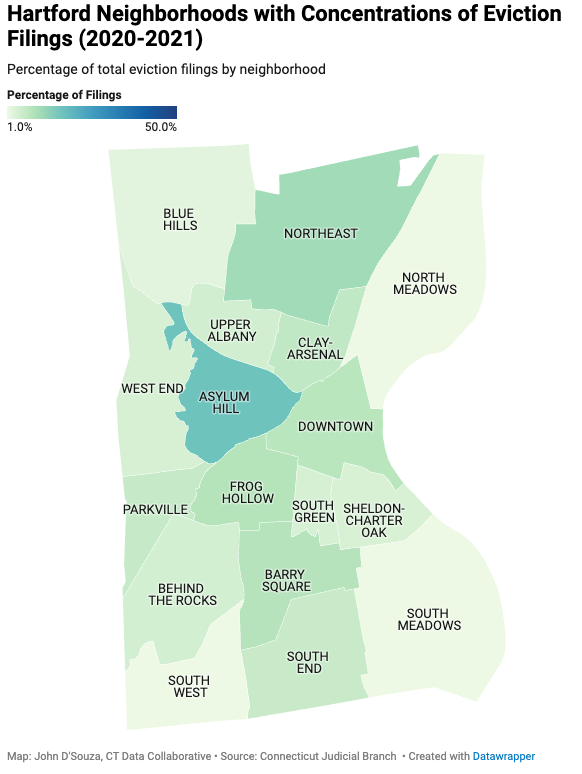Evictions Spotlight on Hartford
In conjunction with CTData’s upcoming analysis of eviction disparities statewide, 2024 Hartford Youth Data Fellows analyzed eviction filings data across Hartford neighborhoods, and brought in additional datasets on housing costs, rental assistance, and physical and mental health to better understand the impact of evictions across the city and within neighborhoods.
Evictions and Rent in Hartford
Kumari Sampson, 2024 Hartford Youth Data Fellow, analyzed trends of evictions across Hartford alongside increases in rental housing costs from 2017 through 2024. Read the complete analysis here.
Hartford has seen an increase in evictions over the past 7 years. During the pandemic, you see a decrease in the amount of evictions that occurred mainly due to the rent control policy to help residents during COVID-19 times when the economy was stagnant. In 2021 when the policy was revoked as the pandemic ended you see an even greater rise of evictions compared to the pre-pandemic.
Zillow reported this year that Hartford has one of the highest rents in the country. The increases in rent contribute to Hartford's underlying problem with eviction. Hartford had among the highest annual rent increases in the country at 6.4% and those those living in multifamily homes experiences an average annual of 6.4%
Evictions by Neighborhood
John D’Souza, 2024 Hartford Youth Data Fellow, analyzed trends in evictions by neighborhood from 2017-2019 to 2020-2021 and looked at how statewide rental assistance funds were distributed geographically and demographically. Read the complete analysis here.
Understanding trends in evictions filings allows us to better understand how to intervene to help families facing the loss of their homes. Responding to the COVID-19 pandemic, Connecticut enacted an evictions moratorium that expired on June 30, 2021, and with modified eviction procedures in place through February 15, 2022. Today Hartford is in a housing affordability crisis, with an uptick in eviction filings postpandemic. Reviewing court filings, I found a notable rise in the percentage of eviction dispositions across all neighborhoods.
Mapping evictions filings by neighborhood in Hartford, Asylum Hill stands out with the highest percentage of filings. The chart highlights a notable drop in eviction dispositions across Hartford, CT neighborhoods from 2020 to 2021, with rates declining to 15-18%, reflecting the effectiveness of eviction prevention measures and rental assistance programs. This shows how policy measures to block evictions were able to safeguard tenants, providing temporary relief and promoting housing stability.
Effects of Evictions in Hartford
Alex Roberts, 2024 Hartford Youth Data Fellow, analyzed the number of evictions and presence of counsel for tenants facing eviction by neighborhood, with a focus on North End neighborhoods, as well as mental and physical health by neighborhood. Read the complete analysis here.
The eviction process can be very daunting and draining which can affect several aspects of a person's life. From school to work to family to socializing, eviction can put a strain on one’s health and well-being. It can affect people mentally, emotionally, and even physically.
According to the data released in 2023 by the Center for Disease Control, many of the neighborhoods in Hartford have residents who report experiencing low mental and physical health for consistent amounts of time. Neighborhoods such as Barry Square and Blue Hills struggle with mental health more while areas such as the Northeast and Behind the Rocks struggle more with physical health issues. Furthermore, there are places like the Upper Albany, Clay-Arsenal, and Parkville areas where mental and physical health are both a struggle.
The data found in these charts are not directly taken from residents who have been evicted and cannot be directly correlated with eviction. However, knowing about the stress of eviction and looking at places with a high concentration of eviction fillings, we can infer that eviction could have played a role in the low mental and physical health of Hartford residents.
For More Information
Hartford Youth Data Fellows create community-based data projects through a paid fellowship with the Hartford Data Collaborative. To read more about their work and see the full data projects, click here. If you are interested in learning more about Hartford Data Collaborative, click here. To review more Hartford data projects by CTData, click here. You can keep up with us by subscribing to the CTData newsletter and following us on Twitter, Facebook, and LinkedIn.




